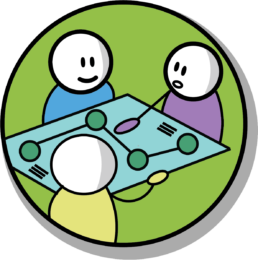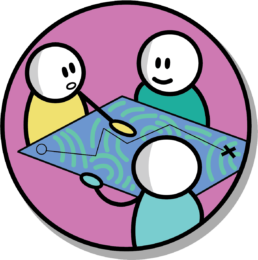Maps
Illustrated maps are a great way to take what can feel abstract and conceptual, or, what can feel numbers-driven and inhuman, and make it into something people can connect with. Maps are such powerful tools for communication and drivers for action. A map is not simply a picture to admire, it is a set of instructions for how you get from one place to another. Illustrated maps can be used to share strategy, to capture an experience or articulate a location. Each map we create is unique and built out of a deep customer collaboration.
Strategy Map
Have your strategy, culture, or change journey drawn as a visual map that people will connect with.
When we approach a strategy map we like to start by having the customer talk us through it, because we want to hear the language choices they make. As they talk we are on alert for keywords, after a while we usually see a pattern or a theme start to emerge that, with a bit of imagination, lends itself to a visual scene. From there we start to tease the idea out and stretch it in a few directions – does the analogy hold up if we stretch it over here? Does it still make sense when we add this layer? The goal when we are done is to create a visual story scene that holds within it the messages of the strategy. The most powerful thing about presenting strategy like this is that it gives the audience a common language to unite around. The FY20 growth target is no longer just a number, it might now be an aeroplane or a stepping stone in a river. Suddenly it is alive with narrative and we have a shared way to talk about it.

Experience Map
Experiences, activities movements – these can feel intangible and hard to visualise. We can help you represent them on paper to make them real for others.
The younger of our audience may not actually remember referencing a physical paper map in order to traverse a physical environment. While for the most part, maps are now in the digital sphere, that is also what makes a hand drawn map on paper kind of special. Our physical maps, while beautiful, do not follow the rules of traditional map making – measurements are not necessarily proportionately accurate. But that is not important when your physical map is about being able to stand like a giant and wrap your mind around something you could not understand as a mere human standing inside it. A physical map is a great birds eye view of something. We like to treat physical maps as if we’re building the viewer an experience map of what they can expect as they move through a place, a series of vistas that they can happen upon. They can showcase landmarks, give directions, even empower an adventurous mind to step forward.

Location Map
As visual creatures, sometimes we need a pictorial representation of a physical space, location, in order to fully comprehend it. A custom, drawn map could help.
These kinds of maps are sometimes the output of a great deal of experience or user design research with customers to understand a current state. Sometimes they are the expression of a desired state – either way, experience by its very nature is conceptual and can be difficult to articulate with words alone. That is where pictures come in. There is plenty of great software out there that allows you to capture in table form the attributes and details of an experience, but in our opinion it would be a shame to stop there. We like to take that kind of great input and create for the viewer a series of snapshots, like a set of window scenes to peek through into the experience. An experience map when working at its best can invoke deep empathy in the viewer, inspire emotional responses and motivate decision makers to make change happen.
